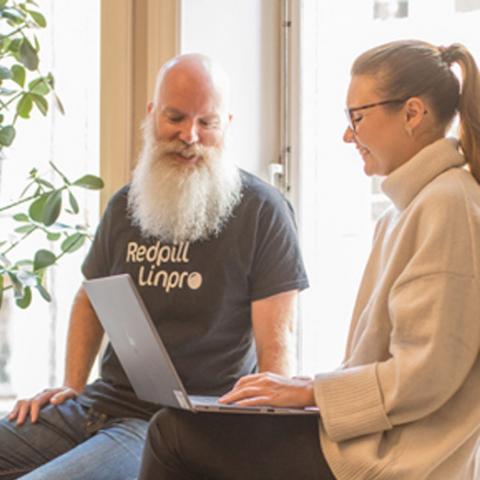
Clear goals and priorities
Ensure that the team has clear and measurable goals and a clear understanding of which initiatives and tasks are of the highest priority. Focus on what brings the most value to customers and the business, and avoid getting stuck in excessive discussions about less important details.
It's easy for discussions during meetings and ceremonies to go off track, and participants may start discussing solutions to problems, initiating work that is supposed to start during the sprint. Try to steer such discussions to other occasions, but also be considerate and have some finesse so that you don't come across as the team's dictator who always interrupts interesting discussions.
Remember that we are all human and have a need to communicate and receive acknowledgment for different things. If you constantly interrupt all discussions, team members will eventually perceive that you lack empathy for them and only focus on hard, cold results.
We have also previously emphasized the importance of all stakeholders and team members having an understanding of the priorities and being on board with why things are as they are.
Agile principles
Use agile principles like "Fail fast, fail forward" and "Iterative work" to encourage quick prototypes and experiments. This helps the team get started swiftly and receive feedback early in the process, instead of getting stuck in endless theoretical discussions.
"Fail fast, fail forward" means that if problems arise or an experiment fails, the team shouldn't get bogged down in the problem but quickly identify the cause and learn from it. Rather than seeing failures as obstacles, view them as opportunities to learn something new and improve going forward. This encourages an environment where the team is not afraid to try new things because they know that if something doesn't work as expected, they can quickly adjust and move in the right direction.
Of course, don't push the team so hard that they are constantly jumping to new tracks. They need time to reflect on things and utilize the experiences they build up within the team.
If a team creates a quick prototype and realizes that the user interface is not intuitive, they should not get stuck trying to perfect it but quickly adapt based on user feedback, identify problematic areas, and rapidly iterate on the design. This reminds us of the same issue that artists face when creating their works. An artwork can be polished and refined indefinitely, but at some point, you have to let it go and consider it finished.
The iterative approach means that the team divides the work into small, manageable parts and works on them in short cycles, often called "sprints" or "iterations." The team delivers value in small increments instead of trying to complete the entire project at once. This enables regular feedback and validation from customers and stakeholders, making it possible to adapt and improve the product based on real reactions and needs.
For example, if a development team is working on implementing a new feature, they shouldn't wait until the entire feature is complete to start testing it. Instead, they should break the work into smaller parts, implement one part, and test it as soon as possible. Then they can iterate and improve the feature based on user feedback. With today's tools, it's effortless to present several parallel tracks with alternative solutions, especially concerning user interfaces.
MVP (Minimum Viable Product)
Strive to quickly build a Minimum Viable Product (MVP) that can deliver basic functionality to customers. This allows the team to start delivering value rapidly and continuously improve the product based on customer feedback. In the past, this wasn't as easy, as creating a functioning prototype sometimes required considerable development efforts.
However, the underlying concepts are not new in any way. Prototyping has been used in various forms since the 1970s, but the difference in today's environments is that it is often extremely fast to produce something that can be presented to stakeholders. There are numerous tools that are excellent at creating prototypes in various forms, whether it's user interfaces, Java code, Python code, JavaScript, database connections, APIs, CRUD operations, and more.
Retrospective
Conduct regular retrospectives to reflect on the team's work and identify areas for improvement. This helps the team continuously evolve and avoid getting stuck in the same patterns of overanalysis. Holding regular retrospectives is vital in the ongoing work of improving the team. Here are some tips to make retrospectives more successful and avoid overanalysis and endless discussions:
- Set a fixed time frame - Decide on a clear time frame for retrospectives and stick to it.
- Prepare an agenda - Take the time to prepare an agenda with the topics to be discussed.
- Use various methods - Vary the format and methods of retrospectives.
- Create a safe environment - Ensure that everyone on the team feels comfortable sharing their opinions.
- Focus on concrete actions - Ensure that the focus is on concrete actions to address issues.
- Follow up on previous actions - Follow up on previous actions and assess their desired impact.
- Evaluate effectiveness - After each retrospective, evaluate its effectiveness.
By using these strategies, you can help the team get the most out of their retrospectives and create a culture of continuous improvement and learning. This will help the team avoid stagnation and getting stuck in ineffective patterns, instead constantly evolving and improving.
By following these tips, you can avoid "analysis paralysis" and instead promote initiative and result-oriented work within your team and organization. Remember that the SAFe framework is a tool, and it's more important to use it as a foundation and adapt it to your team's unique needs and situation rather than following it rigidly.
In the next article, we will take a look at how you can involve PM/SA/BO in your team's operational work in a different way.



